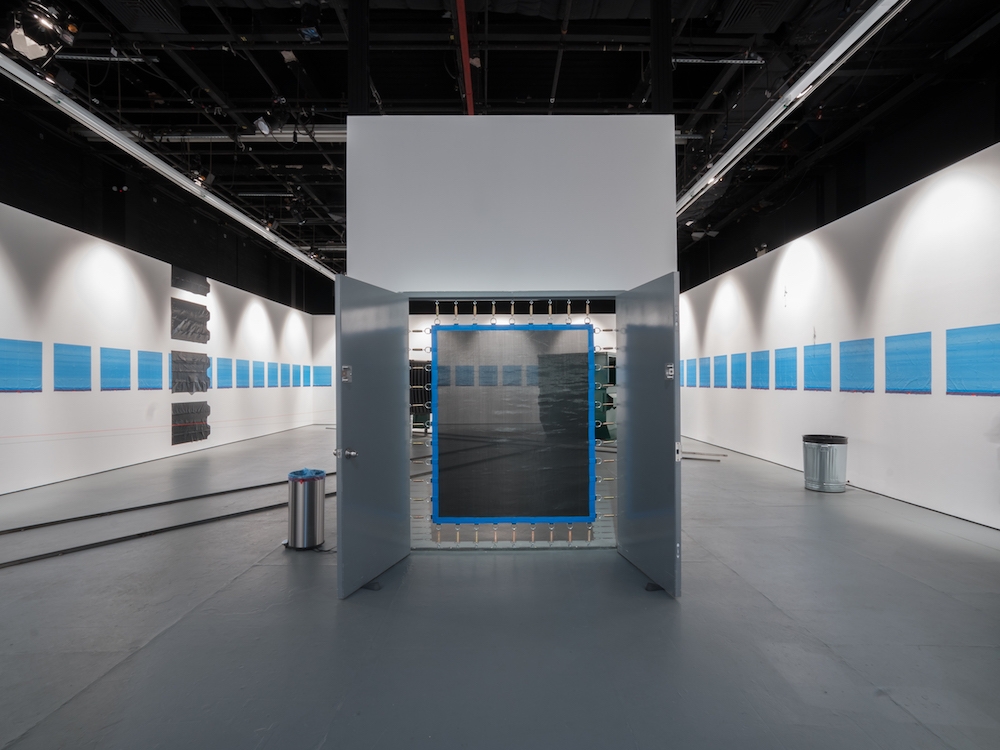The Kitchen, New York, 6 April – 13 May
A video projection shows a small strip of plastic inserted into a tensile testing machine. The plastic is stretched, slowly, until it snaps apart. The viewing experience of Trash Bag Tensile Test (2017) is interrupted from time to time by a series of sharp breaking sounds coming from the opposite end of the gallery. Spreading horizontally to cover another entire wall, the video Flex Test – Steel, Tensile Test – Steel/Brass (2017) is a close-up of a row of metallic sticks. They rupture one by one to generate an uncomfortably loud noise, but the detail of what force caused them to break isn’t visible on screen. The larger-than-human scale of the images in both videos creates a strange sense of awe, and the otherwise familiar materials acquire an alien quality.
As reflected in the title of the show, these two videos document materials reaching their ‘yield points’, an engineering term that refers to the level of stress beyond which a material begins to deform plastically. Yet, Yield Point is not about mechanics or engineering. For Sasamoto, it is a metaphor through which to launch an exploration of ideas concerning the ‘elasticity’ of human existence: a philosophical reflection both on a micro level (the everyday life of individuals) and on a macro level (the environment we inhabited). What constitutes the precarious zone around a breaking point? How to determine the limit before things reach a catastrophic end?
What constitutes the precarious zone around a breaking point? How to determine the limit before things reach a catastrophic end?
The adjacent gallery is filled by a large installation of various found objects and materials: trashcans of different sizes and designs, a couple of green dumpsters sitting on tracks on the ground, and unused blue and black trash-bags flattened onto all four walls of the gallery to create an abstract composition. The arrangement seems at first unimpressive until it is fully engaged and activated by the artist’s performance, of which there are eight during the run of the show.
At that point, designed lighting turns the gallery into a theatrical space. Sasamoto appears in a jumpsuit and begins to interact with the various objects and props. Hidden details slowly reveal themselves. A suspended string of orange LED lights, for example, emerges when two dumpsters are pushed apart, eerily slicing through the darkened space. The trash bags in the trashcans randomly inflate and deflate as if they were able to breath and communicate. As Sasamoto bounces around, throwing an apple to the ground or jumping on a trampoline hidden within the other dumpster, she recounts the tale of a janitor. With a thick marker-pen in hand, she draws charts and diagrams to speculate on ideas of resilience in life: “if you have less elasticity in life, you are easily bored. But if you have more elasticity in life, you may get lost in wandering”
It is not difficult to associate Sasamoto’s portrayal of a janitor and her engagement with trash bags, dumpsters, plastic and degradable materials with issues of waste management and climate change. Since the 1970s, the concept of ‘resilience’ has become a goal of urban planners, ecologists and policy makers. With the increasing environment stress, the concept of resilience points to a system that can absorb shock and continue functioning. It is intriguing to interpret the tensile test in Sasamoto’s videos as a metaphor for the pressure human activities are putting on the planet. But if the planet is no longer understood as something that exists independently of human society, where is the breaking point for our environment?
From the Summer 2017 issue of ArtReview Asia
